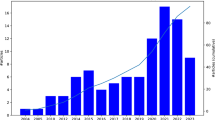Abstract
Many public facility location models have been developed using maximum service distance criteria. Most of these models can be classified as covering modes. This paper expands on the notion of service coverage where the value of coverage is not a constant as in previous models. This varying coverage value when coupled with the Maximal Covering Location Problem yields a set of new models which are more complex but still tractable. These new models provide an approach that is sensitive to many of the issues found in public facility location. Both convex and nonconvex covarage functions are discussed along with their potential use in locating noxious activities.
Similar content being viewed by others
References
Austin, C. M. 1974. The evaluation of urban public facility location: an alternative to benefit-cost analysis.Geographical Analysis 6, 1. 135–145.
Berlin, G. R. and Liebman,J. C. 1974. Mathematical analysis of emergency ambulance location.Socio-Economic Planning Sciences 8, 6, 323–328.
Charnes, A. and Storbeck, J. 1980. A goal programming model for the siting of multilevel EMS systems.Socio-Economic Planning Sciences 14, 4B: 155–161.
Church, R. L. and Bell, T. 1981. Incorporating preferences in location-allocation models.Geographical Perspectives 48: 22–34.
Church, R. L. and Bianchi, G. 1982. Recent developments in covering models for the location of emergency facilities. Paper presented at the ORSA/TIMS Meeting, Detroit, Michigan.
Church, R. L. and Meadows, M. E. 1979. Location modeling utilizing maximum service distance criteria.Geographical Analysis 11, 4: 358–373.
Church, R. and Revelle, C. 1974. The maximal covering location problem.Papers of the Regional Science Association 32: 101–118.
Church, R. L., Roberts, K. L. and Bell, T. L. 1979. Comments on Orloff's net accessibility model.Geographical Analysis 11, 1: 89–93.
Church, R. L. and Weaver, J. R. 1983. Computational procedures for the maximal covering location problem. Presented at the Pittsburgh Conference on Modelling and Simulation, Pittsburgh, PA.
Daskin, M. S. 1981. Application of an expected covering model to EMS system design. Evanston, Illinois: Department of Civil Engineering and the Transportation Center, Northwestern University.
Dwyer, F. R. and Evans, J. R. 1981. A branch and bound algorithm for the list selection problem in direct mail advertising.Management Science 27, 6: 658–666.
Eaton, D. J., Church, R. L., Bennett, V. L., Hamon, B. L. and Lopez, L. V. 1981. Ubicacion de recursos de salud en las zones rurales Del Cauca. Colombia. Austin: Institute for Latin American Studies, University of Texas, Technical Paper Series No. 32.
Efroymson, M. A. and Ray, T. L. 1966. A branch and bound algorithm for plant location.Operations Research 14, 3: 361–368.
Hougland, E. S. and Stephens, N. L. 1976. Air pollutant monitor siting by analytical techniques.Journal of the Air Pollution Control Association 26, 1: 51–53.
Kolesar, P. and Walker, W. E. 1974. An algorithm for the dynamic relocation of fire companies.Operations Research 22, 2: 249–274.
Mirchandani, P. B. 1980. Location decision on stochastic networks.Geographical Analysis 12, 2: 172–183.
Morris, J. G. 1978. On the extent to which certain fixed charges depot location problems can be solved by linear programming.Journal of the Operational Research Society 29, 1: 71–76.
Orloff, C. S. 1977, A theoretical model of net accessibility in public facility location.Geographical Analysis 9, 3: 244–256.
Plane, D. R. and Hendrick, F. E., Mathematical programming and the location of fire companies for the Denver fire department. Boulder, Colorado: Management Science Report Series, Report. No. 74–79, University of Colorado.
ReVelle, C., Bigman, D., Schilling, D., Cohon, J. and Church, R. 1977. Facility location: a review of context-free and EMS models.Health Services Research 12, 2: 129–146.
ReVelle, C. S. and Swain, R. W. 1970. Central facilities location.Geographical Analysis, 2, 1: 30–42.
Rojeski, P. and ReVelle, C. 1970. Central facilities location under an investment constraint.Geographical Analysis 2, 4: 343–360.
Rosenthal, R. E. and Unger, V. E. 1973. A new mixed integer programming algorithm for facilities location. Presented at the National ORSA/TIMS Meeting, San Juan, P.R.
Rosing, K. E., ReVelle, C. S. and Rosing-Vogelaar, H. 1979. Thep-median and its linear programming relaxation: an approach to large problems.Journal of the Operational Research Society 30, 2. 815–823.
Schilling, D. 1976. Multi-objective and temporal considerations in public facility location. Ph.D. Dissertation, Johns Hopkins University Baltimore, Maryland.
Schilling, D., ReVelle, C., Cohon, J. and Elzinga, J. 1980. Some models for fire protection locational decisions.European Journal of Operations Research, 5, 1: 1–7.
Swain, R. 1971. A decomposition algorithm for a class of facility location problems. Ph. D. Dissertation, Cornell University, Ithaca, New York.
Teitz, M. and Bart, P. 1968. Heuristic methods for estimating the generalized vertex median of a weighted graph.Operations Research 16, 6: 955–961.
Toregas, C. and ReVelle, C. 1972. Optimal location under time or distance constraints.Papers of the Regional Science Association 28: 133–143.
Author information
Authors and Affiliations
Rights and permissions
About this article
Cite this article
Church, R.L., Roberts, K.L. Generalized coverage models and public facility location. Papers of the Regional Science Association 53, 117–135 (1983). https://doi.org/10.1007/BF01939922
Issue Date:
DOI: https://doi.org/10.1007/BF01939922




